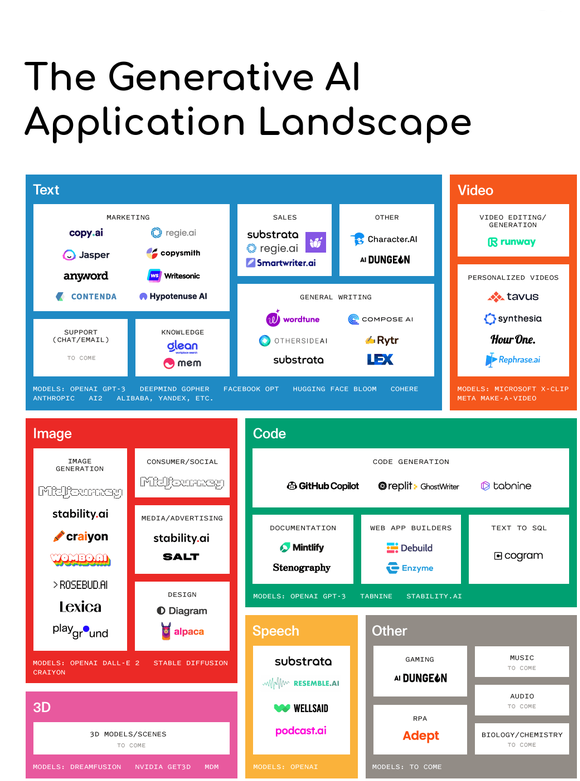Generative AI is taking the world by storm, transforming the way we approach problem-solving and creativity.
The power of Generative AI lies in its ability to create new content, making it a game-changer across various industries.
In this comprehensive, data-driven article, we’ll dive deep into the world of Generative AI, exploring its importance, applications, limitations, and ethical considerations.
So, let’s embark on this fascinating journey and unravel the mysteries of Generative AI.
What is Generative AI?
Generative AI refers to a subset of artificial intelligence that focuses on creating new content or data based on existing examples.
It uses techniques like Generative Adversarial Networks (GANs), Variational Autoencoders (VAEs), and Generative Pre-trained Transformers (GPT) to generate everything from images and videos to text and music.
Generative AI models learn patterns from the input data and use these patterns to generate new, unique outputs.
For instance, GPT-3, developed by OpenAI, is a powerful language model that has demonstrated remarkable capabilities in tasks such as text generation, translation, and even coding.

Importance of Generative AI
Generative AI is important for several reasons:
Boosting Creativity
Generative AI can augment human creativity by providing new ideas, patterns, and solutions that may not have been previously considered. This can lead to novel designs, product innovations, and artistic breakthroughs.
Automation of Content Generation
Generative AI can be used to automate content generation, allowing businesses to create and deliver personalized content quickly and efficiently. This can save time, resources, and improve customer engagement.
Enhancing Data Privacy
Generative AI can create synthetic data, enabling organizations to analyze and model data without accessing sensitive personal information.
Solving Complex Problems
Generative AI can help tackle complex problems by exploring a vast range of possibilities and generating potential solutions.
Applications of Generative AI
Generative AI has numerous applications across various industries:
Art and Design
Generative AI can produce unique artwork, designs, and architectural layouts, offering fresh perspectives and ideas.
Healthcare
Generative AI can create realistic medical images for training purposes, improving diagnostics and treatment plans.
Entertainment
From video game design to movie scripts, Generative AI is revolutionizing the way content is created in the entertainment industry.
Marketing and Advertising
Generative AI can generate personalized marketing content, such as ad copies, social media posts, and email campaigns, enhancing customer engagement.
Limitations and Ethical Considerations
While Generative AI offers numerous benefits, it also presents some limitations and ethical concerns:
Bias
Generative AI models may perpetuate or amplify biases present in the training data, leading to biased outputs.
Intellectual Property
The ownership and rights of AI-generated content remain a controversial topic, raising questions about copyright and authorship.
Misuse
Generative AI can be used to create deepfakes, fake news, and spam content, which can cause harm and misinformation.
Quality Control
Ensuring the quality and accuracy of AI-generated content can be challenging, as AI models might generate nonsensical or irrelevant outputs.
FAQ’s
What is the difference between GANs, VAEs, and GPT?
GANs (Generative Adversarial Networks) consist of two neural networks competing against each other to generate realistic data.
VAEs (Variational Autoencoders) are a type of autoencoder that learn to generate new data by optimizing a lower-dimensional latent space.
GPT (Generative Pre-trained Transformer) is a transformer-based model primarily used for natural language processing tasks, such as text generation and translation.
How does Generative AI impact job opportunities?
Generative AI can both create and displace job opportunities. While it may lead to job losses in certain fields, such as content creation, it also creates new opportunities for AI engineers, data scientists, and creative professionals who can collaborate with AI.
Can Generative AI completely replace human creativity?
While Generative AI can enhance human creativity and offer new perspectives, it is unlikely to completely replace human creativity.
AI-generated content still requires human input, guidance, and interpretation to ensure quality, relevance, and alignment with specific objectives.
How can we mitigate the ethical concerns surrounding Generative AI?
To address the ethical concerns, organizations should prioritize transparency, fairness, and accountability when developing and deploying Generative AI models.
This includes using unbiased data, continuously monitoring model performance, and establishing ethical guidelines to prevent misuse.
Conclusion
Generative AI is a powerful and transformative technology that is shaping the future of creativity, problem-solving, and content generation.
By understanding its importance, applications, limitations, and ethical considerations, we can harness its potential to drive innovation and enhance human capabilities.
So, embrace the world of Generative AI and unlock new possibilities in your industry!
Thank you for reading our blog, we hope you found the information provided helpful and informative. We invite you to follow and share this blog with your colleagues and friends if you found it useful.
Share your thoughts and ideas in the comments below. To get in touch with us, please send an email to dataspaceconsulting@gmail.com or contactus@dataspacein.com.
You can also visit our website – DataspaceAI



